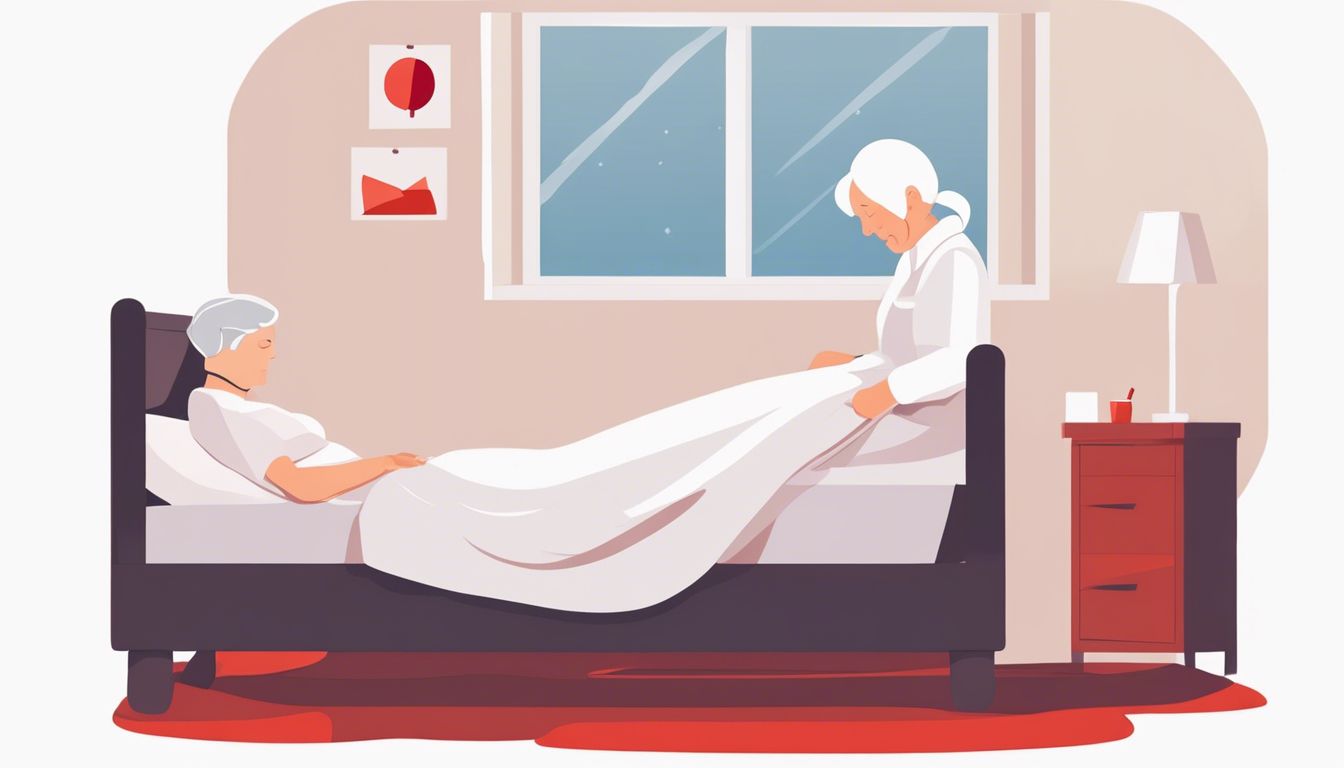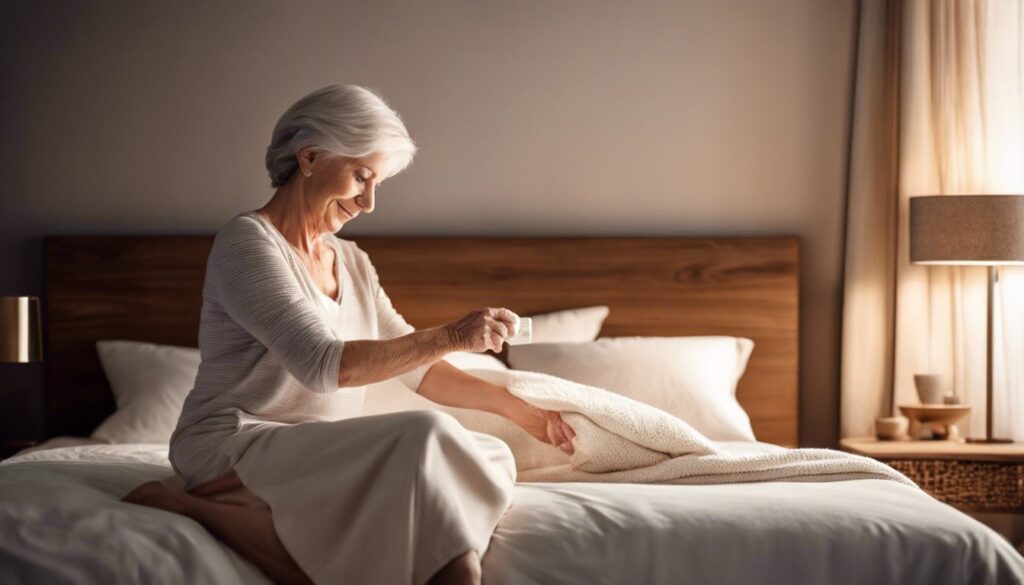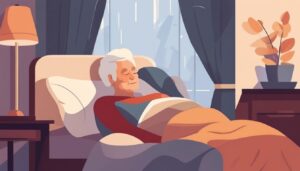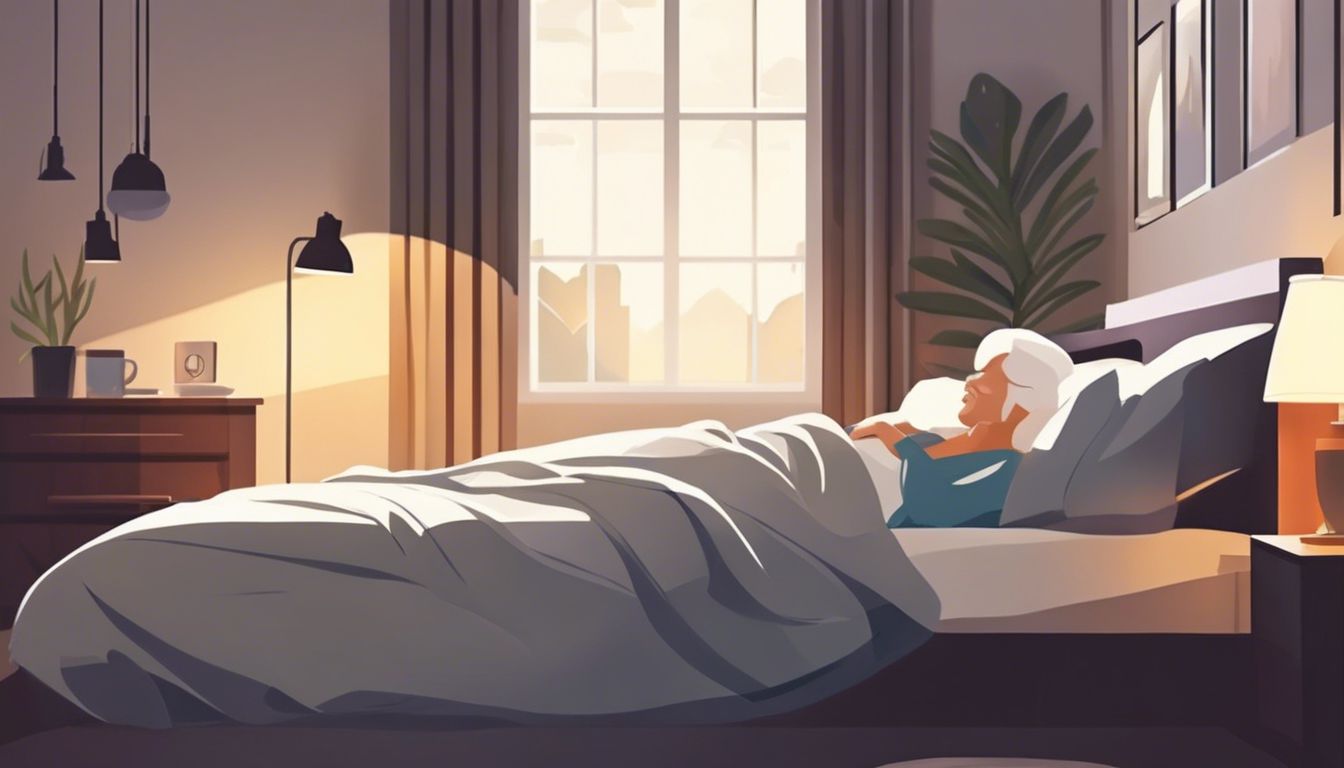Caring for bedridden seniors can be challenging, especially when it comes to preventing bed sores. These painful pressure ulcers affect up to 23% of nursing home residents. This guide will show you practical steps to keep your loved one’s skin healthy and comfortable.
Ready to learn how to stop bed sores before they start?
📋✅
- Bed sores affect up to 23% of nursing home residents, often appearing as red, warm areas on bony parts of the body like the tailbone, heels, and hips.
- Repositioning seniors every 2 hours in bed and every 15 minutes in wheelchairs helps prevent pressure ulcers by improving blood flow to vulnerable areas.
- Using specialized air mattresses, cushions, and pillows spreads out pressure and reduces the risk of skin breakdown in bedridden seniors.
- Daily skin cleaning, moisturizing, and protecting against excess moisture are key steps in maintaining skin health and preventing bed sores.
- A diet rich in protein, vitamins A, C, and E, zinc, and omega-3 fatty acids, along with proper hydration, supports skin integrity and wound healing in older adults.
Recognizing the Early Signs of Bed Sores

Bed sores often start as red, warm areas on the skin. These spots may feel different from surrounding skin and hurt when touched.
Common sites of pressure ulcers
Pressure ulcers often develop in specific areas of the body where bone and skin are in close contact. For bedridden individuals, these spots include the back or sides of the head, shoulder blades, lower back, tailbone, heels, and ankles.
Wheelchair users frequently experience pressure sores on their tailbone, buttocks, shoulder blades, and the backs of their arms and legs.
Prevention is the best cure for pressure ulcers.
These injuries aren’t limited to one area – they can occur anywhere prolonged pressure is applied to the skin. The hips, knees, and skin behind the knees are also common sites. Nursing home residents are particularly at risk, with more than 1 in 10 experiencing a pressure injury.
Understanding these high-risk areas helps caregivers focus their preventive efforts effectively.
Early symptoms to watch for
Early signs of pressure sores often appear as changes in skin color or texture. Caregivers should look for reddish, bluish, or purplish patches on the skin – especially in areas that bear weight when sitting or lying down.
These spots may feel warmer, cooler, or firmer than surrounding skin. Swelling, tenderness, or blisters can also signal the start of a pressure injury.
Other warning signs include skin that stays red after pressure is removed, or areas that feel different from nearby skin. Pus-like drainage or a foul odor may indicate infection. Systemic symptoms such as fever, chills, or confusion could mean the problem has spread beyond the skin.
Regular skin checks are crucial for catching these issues early before they worsen into open sores or deeper wounds.
Strategies to Prevent Bed Sores
Preventing bed sores in seniors requires active care and attention. Regular repositioning and the use of specialized support surfaces are key strategies to reduce pressure on vulnerable areas.
Frequent repositioning
Frequent repositioning is crucial for preventing bed sores in seniors. Caregivers must help their loved ones change positions every two hours while in bed. This constant movement reduces pressure on vulnerable areas like the tailbone, hips, and heels.
For those using wheelchairs, shifting weight every 15 minutes is vital. These small but frequent adjustments promote blood flow and minimize the risk of skin damage.
Proper techniques for repositioning are essential. Use pillows to support the body and reduce friction during moves. Lift, don’t drag, the person to avoid skin tears. For wheelchair users, encourage exercises like push-ups or leaning side-to-side.
These simple actions can make a big difference in maintaining skin integrity and overall health for seniors at risk of pressure injuries.
Use of specialized mattresses and cushions
Specialized mattresses and cushions play a crucial role in preventing bed sores. Air mattresses that alternate pressure points can significantly reduce the risk of pressure ulcers.
These high-tech beds redistribute weight and minimize prolonged pressure on vulnerable areas. For wheelchair users, specialized cushions with gel or foam inserts provide comfort and protection.
These adaptive surfaces contour to the body, spreading pressure evenly across a larger area.
Caregivers should avoid using doughnut-shaped cushions, as they can restrict blood flow. Instead, opt for pressure-relieving pads or cushions designed for specific body parts. Adjustable bed frames allow for easy repositioning, which is essential for pressure relief.
Remember to check and maintain these specialized surfaces regularly to ensure they’re functioning correctly and providing optimal protection against skin breakdown.
The Role of Pillows in Enhancing Senior Sleep Quality and Preventing Bed Sores
Pillows play a crucial role in preventing bed sores and improving sleep quality for seniors. They help maintain proper body alignment and reduce pressure on vulnerable areas. Placing pillows between the legs, under the back, or beneath the arms can distribute weight evenly, minimizing the risk of pressure ulcers.
This simple yet effective strategy is especially beneficial for those on extended bed rest.
Smooth bedding is essential for skin protection, and pillows aid in achieving this. They can fill gaps between the body and mattress, reducing friction and shear forces that contribute to skin breakdown.
Caregivers should ensure pillows are positioned correctly and adjusted regularly to maximize comfort and prevention. Using specialized cushions or foam pads in addition to pillows can further enhance pressure relief and support overall skin health.
Skin Care and Maintenance
Proper skin care is vital in preventing bed sores. Keeping the skin clean and dry helps ward off infections and irritation. Regular moisturizing supports skin elasticity and health, reducing the risk of breakdown.
Keeping the skin dry and clean
Maintaining dry, clean skin is crucial in preventing bed sores. Caregivers should wash the senior’s skin daily with mild soap and warm water, paying extra attention to areas prone to moisture like skin folds.
After cleansing, pat the skin dry gently – don’t rub. Apply moisture barrier creams to protect against excess wetness from sweat or incontinence.
Frequent checks and quick action are key. Change wet clothing or bedding right away. For seniors with incontinence, use absorbent pads and check them often. Loose, breathable clothing helps air circulate and keeps skin drier.
These simple steps can make a big difference in skin health and comfort for seniors at risk of bed sores.
Using moisturizers to prevent dryness
Moisturizers play a crucial role in preventing skin dryness and maintaining skin health for seniors at risk of bed sores. Daily application of a gentle, fragrance-free lotion or cream helps lock in moisture, keeping the skin supple and less prone to breakdown.
This simple practice can significantly reduce the risk of pressure ulcers forming on vulnerable areas like the heels, elbows, and tailbone.
Caregivers should choose products with ingredients such as glycerin, hyaluronic acid, or ceramides for optimal hydration. Apply the moisturizer after bathing, when the skin is still slightly damp, to maximize absorption.
Gently massage the product into the skin, paying extra attention to bony prominences and areas prone to pressure. The next important step in preventing bed sores involves addressing and managing underlying health conditions that may contribute to skin breakdown.
Nutritional Guidelines to Support Skin Health
Proper nutrition plays a vital role in maintaining healthy skin. A well-balanced diet rich in vitamins A, C, and E can boost skin health and aid in wound healing.
Importance of hydration
Proper hydration is crucial for seniors to prevent bed sores. Caregivers should ensure their loved ones drink 8-10 cups of water daily. This helps maintain skin elasticity and promotes better circulation, reducing the risk of pressure ulcers.
For seniors with heart failure or kidney disease, fluid intake needs careful monitoring. Always follow doctor-recommended dietary restrictions.
Adequate hydration supports wound healing and overall skin health. It aids in nutrient delivery to skin cells and helps flush out toxins. Dehydration can lead to dry, fragile skin more prone to damage.
Caregivers can offer water, herbal teas, or flavored water to encourage drinking. The next section covers nutritional guidelines for supporting skin integrity in seniors.
Recommended diet for skin integrity
A nutritious diet plays a vital role in maintaining skin integrity for seniors. Protein-rich foods like lean meats, fish, eggs, and legumes help repair and rebuild skin tissue. Fruits and vegetables high in vitamin C (citrus fruits, berries, leafy greens) boost collagen production, essential for skin elasticity.
Zinc-rich foods such as nuts, seeds, and whole grains support wound healing and skin cell renewal.
Hydration is crucial for skin health. Seniors should aim for 6-8 glasses of water daily, supplemented with hydrating foods like cucumbers, watermelon, and soups. Omega-3 fatty acids found in fatty fish, flaxseeds, and walnuts reduce inflammation and keep skin supple.
Limiting processed foods, sugar, and alcohol helps prevent skin damage and promotes overall skin integrity in older adults.
Addressing and Managing Underlying Health Conditions
Managing health issues is key to preventing bed sores. Diabetes and poor blood flow can increase the risk of pressure ulcers, so regular check-ups are vital.
Managing diabetes and circulation issues
Diabetes and poor circulation can increase the risk of bed sores in seniors. Blood sugar control is key for diabetics – regular monitoring and medication as prescribed by a doctor help prevent complications.
For circulation issues, gentle exercise like short walks or seated leg lifts boosts blood flow. Compression socks also aid circulation in the legs and feet. Proper foot care is crucial – daily inspections, moisturizing, and wearing well-fitting shoes protect vulnerable areas.
A healthy diet supports both diabetes management and circulation. Foods rich in vitamins C and E promote skin health and healing. Omega-3 fatty acids found in fish oil may improve blood flow.
Staying hydrated is vital – seniors should aim for 6-8 glasses of water daily, unless restricted by their doctor. Regular check-ups allow healthcare providers to monitor overall health and adjust treatments as needed.
Importance of regular medical check-ups
Regular medical check-ups play a crucial role in managing a senior’s health. These visits allow healthcare providers to monitor chronic conditions, assess medication effectiveness, and catch potential issues early.
For caregivers, these appointments offer valuable insights into the overall well-being of their loved ones. Doctors can provide guidance on preventing bed sores, adjusting care routines, and addressing any concerns about skin integrity or circulation.
Medical check-ups also serve as an opportunity to review and update care plans. Healthcare professionals can evaluate the need for specialized equipment, such as pressure-relieving mattresses or cushions.
They may recommend changes in diet, exercise, or positioning to reduce the risk of pressure ulcers. Caregivers should actively participate in these discussions, sharing observations and seeking advice on maintaining optimal health for seniors in their care.
Preventing bed sores in seniors demands constant vigilance and care. Regular skin checks, proper nutrition, and frequent repositioning form the foundation of effective prevention. Specialized equipment like air mattresses and cushions can provide extra support.
Caregivers play a crucial role – their attentiveness can make all the difference in maintaining skin health and overall well-being for seniors at risk.
Discover how the right pillows can improve sleep quality and aid in preventing bed sores by visiting The Role of Pillows in Enhancing Senior Sleep Quality.
FAQs
1. What are bed sores, and why are seniors at risk?
Bed sores, also called decubitus ulcers, are skin wounds. They happen when someone stays in one spot too long. Seniors often can’t move much. This puts them at risk. Poor nutrition and health problems make it worse.
2. How can we stop bed sores in nursing homes?
Nursing homes can help prevent bed sores. They should turn patients often. Use special mattress toppers. Keep skin clean and dry. Watch for early signs like redness. Good nutrition is key. So is treating other health issues.
3. What role does nutrition play in preventing pressure wounds?
Nutrition is vital. Seniors need the right nutrients to keep skin healthy. Being undernourished raises the risk of pressure wounds. Tube feeding or IV nutrition might help if eating is hard. A good diet helps the body heal and fight infection.
4. Can incontinence lead to bed sores?
Yes, it can. Wet skin from urinary incontinence is more likely to break down. This can cause bed sores. It’s important to keep skin dry. Change often. Use barrier creams like Desitin. These steps help protect the skin.
5. How do neurological disorders affect bed sore risk?
Neurological disorders can increase bed sore risk. They may cause loss of sensation. This means a person might not feel discomfort and shift position. Spinal cord injuries are a big risk factor. Cognitive decline can also play a role.
6. What should caregivers watch for to catch bed sores early?
Caregivers should check skin daily. Look for redness, especially over bony areas. Watch for changes in skin color, temperature, or firmness. Check for open wounds or blisters. Early signs might look like a bruise or diaper rash. Quick action can stop small issues from becoming big problems.









